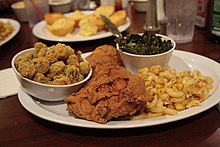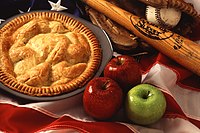
| Part of a series on |
| American cuisine |
|---|
 |
This is a list of soul foods and dishes. Soul food is the ethnic cuisine of African Americans that originated in the Southern United States during the era of slavery.[1] It uses a variety of ingredients and cooking styles, some of which came from West African and Central African cuisine brought over by enslaved Africans while others originated in Europe. Some are indigenous to the Americas as well, borrowed from Native American cuisine.[1][2] The foods from West-Central Africa brought to North America during the slave trade were guinea pepper, gherkin, sesame seeds, kola nuts, eggplant, watermelon, rice, cantaloupe, millet, okra, black-eyed peas, yams, and legumes such as kidney beans and lima beans. These crops became a staple in Southern cuisine in the United States.[3][4][5] Soul food dishes were created by enslaved Black Americans using minimal ingredients because slaveholders rarely fed their slaves. Historian John Blassingame's book published in 1972, The Slave Community: Plantation Life in the Antebellum South, was researched from a collection of slave narratives. According to Blassingame's research, some enslaved people received the bare minimum in food and had to supplement their diets by hunting, fishing, and foraging for food.[6][7] From their limited food sources enslaved African Americans created their meals and new dishes called soul food.[8]
Many of the meals prepared by enslaved people were later published in African-American cookbooks after the American Civil war. The dishes the enslaved and their descendants created influenced American southern cuisine.[9] An article from the Alabama News Center explains: "In recent years, culinary historians and writers have credited Africans with introducing many new cooking techniques (for example, one-pot cooking, deep-fat frying and using smoked meats as seasoning) as well as dishes to the New World. They created gumbo, an adaptation of a traditional west African stew; stewed tomatoes and okra; corn cakes, shrimp and grits; hoppin’ John, jambalaya, red rice and other rice-based dishes; collards and other greens; chow-chow and other pickled vegetables; boiled peanuts and peanut soup; and chitlins and cracklings, among other foods."[10][11]
- ^ a b Cite error: The named reference
hogwas invoked but never defined (see the help page). - ^ Ferguson 1993
- ^ Holloway, Joseph. "African Crops and Slave Cuisine". Slave Rebellion Info. Slave Rebellion Website. Retrieved 31 May 2024.
- ^ "Diet and Nutrition". Santa Clara University Digital Exhibits. Santa Clara University. Retrieved 21 June 2024.
- ^ McLaughlin, John. "A Guide to Planting an African-American/African Focused Yard in Miami-Dade County: An Overview of Landscape Design and Plants Grown in Traditional African-American Yards" (PDF). University of Florida / IFAS Extension. Retrieved 12 July 2024.
- ^ Blassingame, John (1972). The Slave Community: Plantation Life in the Antebellum South. Oxford University Press. pp. 39, 155–158. ISBN 9780195025637.
- ^ Brown, Shayla (2020). "Slavery, Soul Food and the Power of Black Women". North Jersey News. Retrieved 3 June 2024.
- ^ Lumpkins, Charles. "Soul Food". Oxford African American Studies Center. Oxford University. Retrieved 11 July 2024.
- ^ Deetz, Kelly (2017). Bound to the Fire How Virginia's Enslaved Cooks Helped Invent American Cuisine. University Press of Kentucky. pp. 4, 122–123. ISBN 9780813174747.
- ^ Blalock, Bob (2019). "African-Americans have shaped Alabama's and America's cuisine". Alabama News Center. Retrieved 6 July 2024.
- ^ "Seeds of Survival and Celebration: Plants of the Black Experience" (PDF). Cornell Botanical Gardens. Retrieved 16 June 2024.